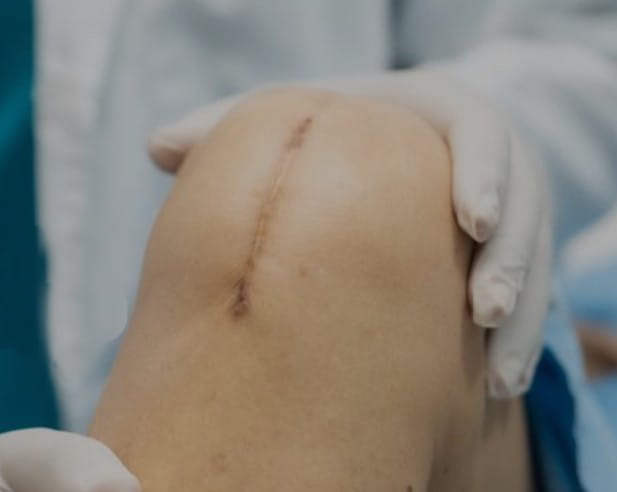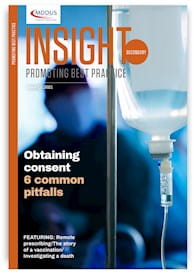
BACKGROUND
Mrs P is a 62-year-old hotel manager who presents to her GP complaining of chronic pain and swelling in her right knee. She requests a referral to a local private orthopaedic clinic, and X-rays reveal varus osteoarthritis of the knee. Treatment is initially with steroid injections but given the degenerative changes in the joint the consultant surgeon – Mr D – discusses further options with the patient, including total knee replacement.
Mr D discusses the pros/cons and risks of the operation, including wound infection, knee pain and stiffness, deep vein thrombosis and periprosthetic fracture. Mrs P opts for total knee replacement and signs a consent form.
Surgery is undertaken using a Rotaglide knee joint secured with acrylic cement. Mr D sizes the prosthesis and undertakes trailing reduction to check the alignment, stability and tracking. An X-ray of the right knee taken the following day shows satisfactory positioning of both prosthetic components with no evidence of fracture. A follow-up examination and radiographs three months later reveal a satisfactory result with adequate knee movement and no periprosthetic bone abnormality and good joint position.
Over the next couple of years Mrs P attends her GP on a number of occasions complaining of back pain and joint tenderness. Further X-rays reveal degenerative changes in her spine and osteoarthritis in the left knee.
Just over three years after her knee replacement surgery Mrs P attends her GP complaining of recent symptoms of pain and swelling in her right knee. Mrs P is referred to a local NHS orthopaedic clinic and X-ray reveals no new adverse features, periprosthetic fracture, evidence of joint infection or loosening. An orthopaedic surgeon at the clinic orders a bone isotope scan and suspects failure of the prosthetic joint, possibly due to varus malalignment.
Mrs P consents to revision surgery but suffers subsequent complications, including wound infection and valgus deformity. Her ongoing recovery remains difficult with chronic pain and mobility issues.
A letter is subsequently sent to Mr D by solicitors representing Mrs P claiming clinical negligence. It is alleged that Mr D failed to carry out surgical treatment with adequate skill and care. In particular he neglected to correctly size and align the implant. This resulted in later failure with the need for revision surgery and an extended period of pain and suffering, and an uncertain prognosis.
ANALYSIS/OUTCOME
MDDUS assesses the case and instructs an expert consultant orthopaedic surgeon to review the evidence. The expert first reviews files prior to the operation and opines that no aspect of the preoperative assessment and consenting procedure fell short of expected clinical standards.
In regard to the procedure itself, he notes that post-operative radiographs indicate a slight varus malalignment of the tibial baseplate but otherwise the prosthetic joint appears to be firmly implanted to a reasonable standard. The expert further opines that this slight varus alignment would not account for Mrs P’s later complaint of persistent knee pain.
X-ray reports in the years subsequent to the operation and prior to the revision surgery show no obvious change in the joint and the expert notes there was no sign of later infection. A bone isotope was undertaken which supported mechanical loosing but the expert points out that this diagnostic method has proven unreliable.
In his summary the expert states that he can find no aspect of the care provided by Mr D that falls short of the standard required in performing a knee replacement.
A letter of response is drafted by MDDUS lawyers on behalf of Mr D denying breach of duty and causation (harm resulting from that breach) and thus any liability. The case is subsequently dropped.
KEY POINTS
- Legal claims can arise long after an alleged incident – crucial is the the date when the claimant became aware of the harm suffered.
- Access to comprehensive case notes and imaging is essential in defending claims of clinical negligence.
- Fully informed consent including potential risks and complications must be evidenced in the patient notes.
This page was correct at the time of publication. Any guidance is intended as general guidance for members only. If you are a member and need specific advice relating to your own circumstances, please contact one of our advisers.
Read more from this issue of Insight Secondary

Save this article
Save this article to a list of favourite articles which members can access in their account.
Save to library
